Over the past couple of years, we have seen Worthington Publishing grow and expand as they are not only putting out more games now, but these games are getting better and better, both in their play and also in their production value. Last year we covered several of their Kickstarter games and posted interviews on our blog including with Darin Leviloff (Soviet Dawn), Maurice Suckling and Dorian Richard (Hidden Strike: American Revolution), Hermann Luttmann (In Magnificent Style), Maurice Suckling (Chancellorsville 1863), Dan Fournie (Battle of the Bulge 1944) and Mike Nagel (Dawn of Battle). We now are trying to make this a regular thing and recently reached out to Grant Wylie (what a fantastic name!) to discuss their upcoming World War II solitaire game called Tarawa 1943.
If you are interested in Tarawa 1943, you can check out the game on the Kickstarter page which launched on January 23rd at the following link: https://www.kickstarter.com/projects/1456271622/612304702?ref=947juo&token=b85beab9
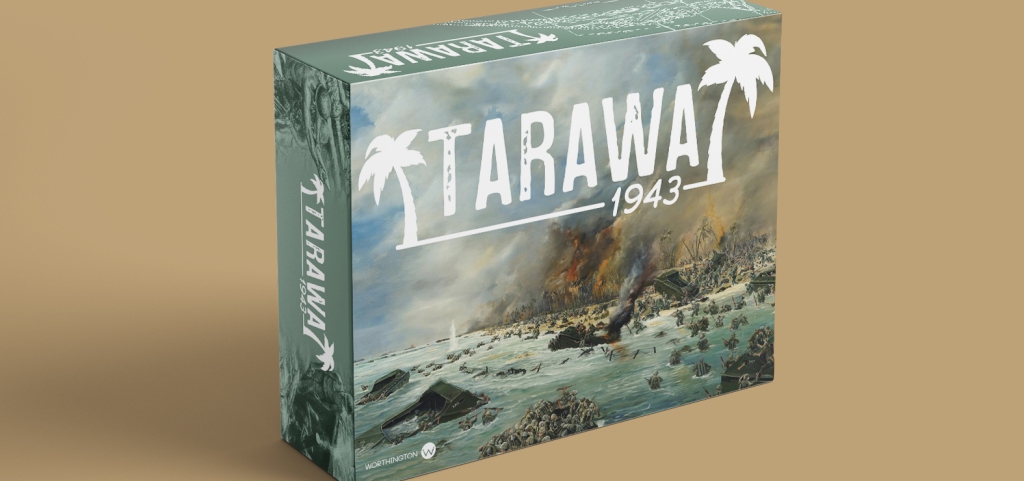
*Because both of our names are Grant (FYI The name Grant means Large or Great and is of English origin), I will refer to myself with Grant K and Grant Wylie with Grant W
Grant K: We have played many of your fine games but this is our first interview with you. Please tell us a little about yourself. What are your hobbies? What was your day job before becoming a wargame designer and publisher?
Grant W: First, let me say thank you for the questions. I love your interviews, reviews, videos, box openings, etc. I am a retired police officer from Virginia Beach Police Department. I was with the department from 1989 until 2017 when I retired. My hobbies are gaming (surprise!) and golf.
Grant K: What got you started down this path of wargame designer and publisher?
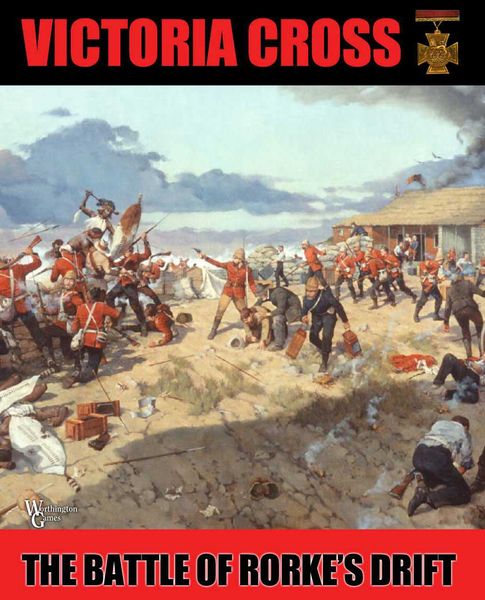
Grant W: My business partner and co-designer on every game is Mike Wylie, I grew up watching him and my dad playing Avalon Hill games when I was younger. We have played games together all my life. In 2004, we came up with Victoria Cross/Rorke’s Drift (based on one of my favorite war movies of all time). We approached a couple of companies about publishing, but felt they wanted to change it too much and would take too long so we jumped into it.
Grant K: What have you enjoyed most about the experience thus far?
Grant W: I’ve always said that I will never write a novel, but the thought that over the next 100 years if some parent sits down with their kids or a friend and play one of our games and enjoy it, then that is what I enjoy most, the thought of that. I (and Mike) love having gamers come up to us and tell us about having had a good time having played one of our games.
Grant K: What is your upcoming Tarawa 1943 about?
Mike W: Tarawa 1943 is about the invasion of Betio Island in Tarawa Atoll in 1943 by the 2nd Marine Division. It was the first invasion to be challenged on the beaches by the Japanese. It was really incredibly lucky I feel that the Japanese didn’t end up pushing the Marines back into the sea. The intelligence failures were significant and some of the luck early in the battle played a crucial role.
Grant K: What did you want to make sure and include from the history of this bloody conflict in the game?
Mike W: The very real possibility that the attack could have failed. From the initial failure to listen to an expert on the tides (which led to the Marines having to wade in), to underestimating the defenders. I also wanted to include the “what would have happened if..” aspect. The Japanese commander was killed early in the fighting. He was tactically brilliant and there is strong belief he would have ordered a massive counter attack on the beaches. After he was killed, the Japanese command structure was destroyed.
Grant K: What system are you using for the game?
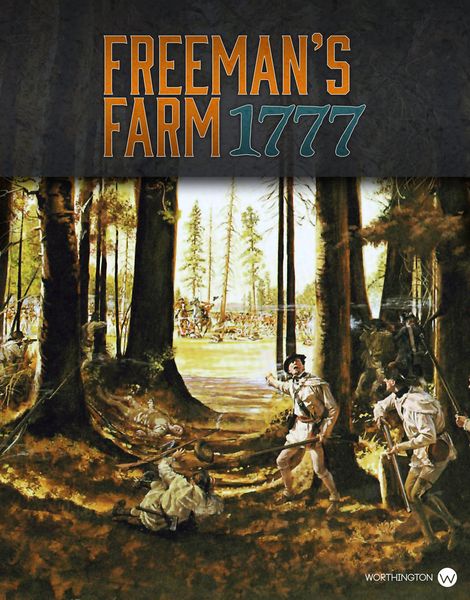
Grant W: It is a combination of Maurice Suckling’s Freeman’s Farm 1777/Chancellorsville 1863 Battle Formations Series plus some elements from Crusaders Kingdoms: The War for the Holy Land. Maurice is brilliant and a good friend and I know the system well. I basically simplified his combat system and movement.
Grant K: What is different with the implementation for this topic?
Grant W: I modified Maurice’s combat system slightly, and the movement is much simpler than in Chancellorsville 1863 as it doesn’t include such a focus on hidden movement. The system is designed to be very bloody. Also, with the cohesion failure the USMC battalion is not eliminated but exhausted and has to be moved out of line or regroup. I took the prioritization of the positions from Crusader Kingdoms in that the Japanese AI is driven to attack the highest priority USMC controlled position.
Grant K: This game is a solitaire game only. What was your reasoning for doing only solo?
Grant W: Solitaire is very popular right now. More importantly, WWII in the Pacific could be very lopsided. I take nothing away from Japanese soldiers, they had massive failures in strategic command and supply. The Japanese soldiers were left on the islands starving, cut off, but fought like hell. Out of the 4,500 man garrison on Tarawa they had 17 surrenders. It is tough asking someone take that role. It works very well solitaire. Set battles are great for this system.
Grant K: What options are there in where the USMC lands on Tarawa?
Grant W: We’ve introduced optional landing beaches. The Japanese commander actually thought the attack would come from the sea, the south. The marines considered that but decided they could get more men in by using the north side beaches. You can also change the initial assault make up (though it is not advised).
Grant K: Can we see the game board? What does it cover on the Island of Betio?
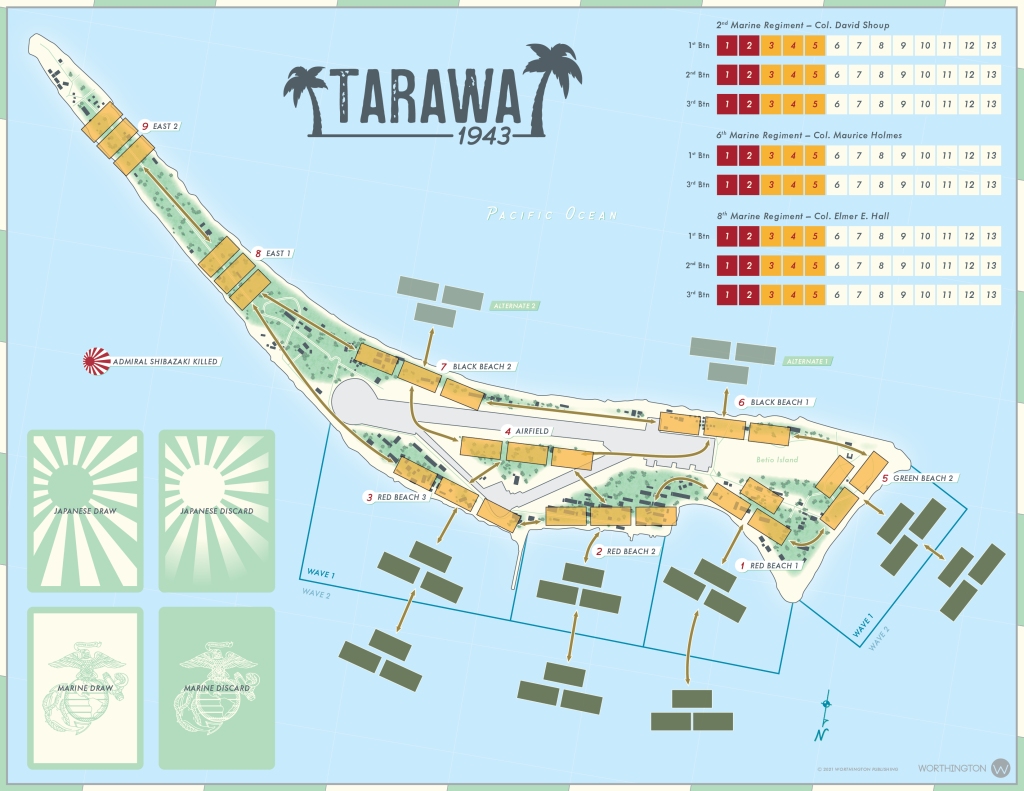
Grant W: The map covers the entire island with various Japanese fortified positions shown at different locations. There are several of the different historical beach landings including Red Beach 1, 2 and 3 and Green Beach and also alternative landing areas including Black Beach 1 and 2. There are positions that must be assaulted from the seas, to the airfield located in the center of the island and that are located up the island as it narrows towards the eastern neck.
Grant K: What are the various positions shown and why do they have three rectangular boxes shown?
Grant W: Each “position” on the island and in the waves is made up of three rectangular boxes. The Japanese defenders are generic in the sense that they are a combined force for what was on the island. Each of the 3 regiments in the 2nd Marine Division are made up of between 2 to 3 battalions with each battalion having 3 blocks. Each turn it will be a battalion (or 3 if you have the Command Coordination card!) that you will activate to move and have combat.
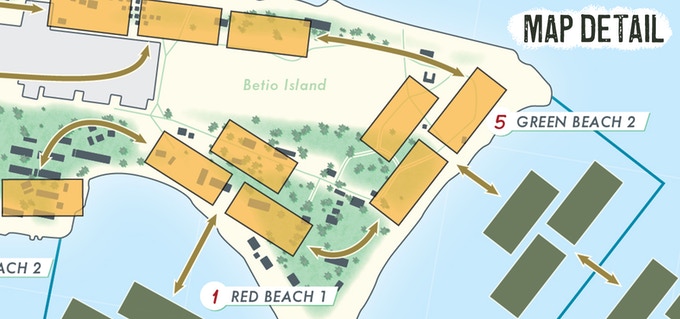
Grant K: What are the differences between island and wave positions in the game?
Grant W: The wave positions are the first line of resistance that the Marines will face. The only way the USMC player wins is if they take the island and control the land positions. Tanks can’t help you in the wave positions. They each really serve the same purpose, but you gotta start taking the island positions to win.
Grant K: What purpose does the USMC Battalion Track serve?
Grant W: The USMC Battalion Track keeps track of the Cohesion of each USMC battalion as it is reduced by activation and combat, or raised by card play or regrouping. Think of this track as the condition, both physical and mental, of each of the USMC battalions fighting on the island.

Grant K: What is the game concept of Cohesion and how does it effect play?
Grant W: Cohesion effectively tracks a battalions “exhaustion/organizational” integrity at a particular time. Men can only fight for so long, and the Cohesion prevents battalions from unrealistically fighting forever to the last man. It is reduced by combat, activating for movement, and raised by regrouping. I’ve read a great account of the battle that talked about battalion’s being moved through each other due to exhaustion. If you’ve ever watched HBO’s excellent series The Pacific you know lack of Cohesion when you see the 1,000 yard stare on soldier’s faces due to combat.
Grant K: What is an Exhaustion Test? What happens when a formation becomes exhausted?
Grant W: Unlike in Freeman’s Farm 1777 or Chancellorsville 1863, in Tarawa 1943 when a unit fails its Cohesion Test it is not eliminated but Exhausted, which means it can no longer be activated to move or attack. The battalion can almost become a road block to forward progress until someone else is moved up OR you spend the time to regroup the unit. Time is the enemy of the USMC player. Keeping casualties low and taking control of the island is the key to victory. There was the real possibility if the casualties were too high or took too long that the US Pacific strategy may have changed.
Grant K: What purpose does the two boxes labeled Shibazaki Alive/Shibazaki Dead serve in the game?
Grant W: The Japanese Commander Shibazaki was brilliant. He had prepared the island well for defense. At the start of the battle he had given up his command post to be a makeshift hospital. As he and his staff were walking to their new command post, a well placed naval shell hit and killed them all. It had a significant impact on the battle and if he is killed in the game, will reduce the effect of Japanese banzai attacks in the game (there is the possibility he doesn’t die). This box simply shows his status, which can change in the game.
Grant K: How does the Japanese AI make their attacks and decisions?
Grant W: The Japanese AI is card driven based on the positions occupied by the USMC battalions. There is an entire deck that is specifically used as the AI and from which actions will be provided. The card system prioritizes attacking the Marines on the beaches and in the water. I’m actually very proud of how well it works.
Grant K: How do they use their cards?
Grant W: The process is very simple, The player flips one card each turn, and based on the situation on the island the effects are applied, whether it is a fire attack, banzai attack, snipers, even Shibazaki being killed are all affected by Japanese AI card play.
Grant K: Can you show us a few examples of these Japanese AI Cards and explain how they are used?
Grant W: Here is a look at a few of these cards including a Fire Attack and Prepared Defense.
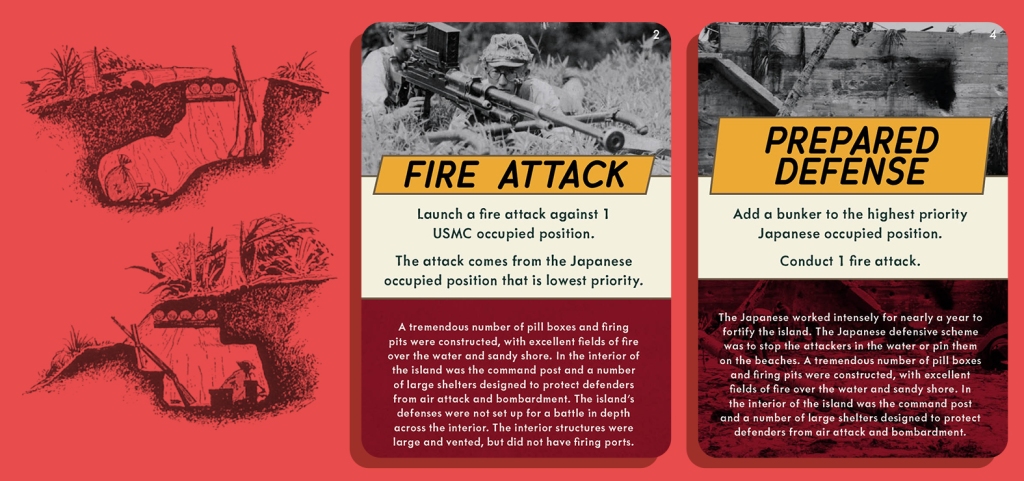
Grant K: How does the player use the USMC Tactic Cards?
Grant W: The USMC Tactic Cards are very simple. They reflect different assets the Marines had such as air support, naval support, engineers to remove bunkers, a Command Coordination card that allows extra movement, things like that.
Grant K: Can you show us a few examples of these Tactic Cards?
Grant W: Here are a few cards including Col. Shoup Leads the Way! and Naval Support.
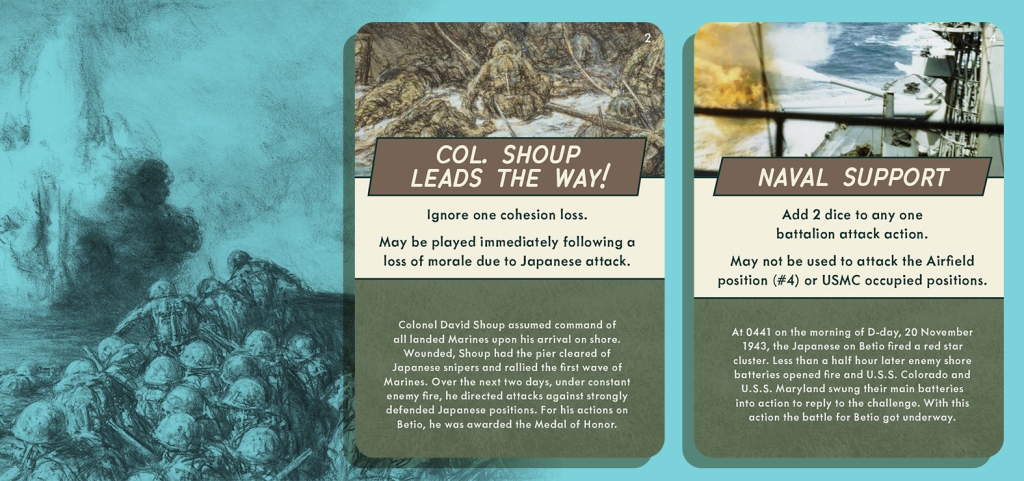
Grant K: How are Bunkers placed in the map and what effect do they provide?
Grant W: Bunkers are placed by card play for both the Japanese AI and USMC. They basically absorb the first hit against a position.
Grant K: How many rounds are in the game?
Grant W: The game typically is 24 rounds long, which consists of 24 Japanese card plays. But the game can be made harder or easier by adding or taking away cards. There are 30 cards. You shuffle and deal 24 to start. To make it easier you can go to 27 cards or all 30 in order to give the Marines more time to secure positions. To make it harder you can go to 21. I haven’t beaten it yet at 21 cards.
Grant K: What is the general Sequence of Play?
Grant W: The Sequence of Play in a round is 1) Play a Japanese AI Card during which the USMC player can play 1 card. 2) Draw USMC cards up to 3 in hand. 3) Activate a USMC battalion to perform actions during which the USMC player can play 1 card.
Grant K: What is the Special Pre-First Round Landing Phase?
Grant W: The only purpose for the Pre-First Round Phase is that is gives the Japanese AI an initial fire attack against the USMC 1st wave as they are coming in from the water. That is one of the reasons that these island invasions are always so bloody is that the beaches were typically heavily defended at first, inflicting lots of casualties due to intense fire supported by in-land artillery.
Grant K: How does Combat work?
Grant W: For the player who is controlling the invading Marines, they will activate a USMC battalion, reducing it’s Cohesion by 1. Select an enemy occupied position that is connected by movement line to attack. The USMC player then rolls five dice, double 6’s and 5’s eliminate a Japanese marker in the position, a die roll result of 4 is removed from the five dice and can’t be rerolled (your men are getting tired and not as effective if you push the attack). Any 3’s rolled are immediately rerolled. Double 2’s reduce your battalions Cohesion by 1, and double 1’s remove a marker from your battalion (you only have 3 and losing an entire battalion is disastrous.) This system is light but has some interesting challenges as you have to manage your individual battalions or you will find that you don’t have anyone left to fight.
For the Japanese they roll 3 dice in a Fire Attack and 5 in a Banzai. The effects for each type of attack are different in that the Banzai is more deadly to both the USMC and Japanese. Fire Attacks are more deadly to the Marines and not as deadly to the Japanese mainly due to fortifications in the form of Bunkers.
Grant K: As you mentioned, the dice combat system creates some interesting challenges and risks. What kind of experience does this create for the player?
Grant W: It creates a system that represents that sometimes things don’t go as planned, but the best laid plans can be screwed up by unexpected surprises. And the decisions are do you accept that, or much like a Marine, improvise, adapt, and overcome by risking it and spending more Cohesion to re-roll.
Grant K: What options are there for a player to re-roll a die?
Grant W: There are certain cards that give a re-roll, but the easiest way but most costly is to spend another Cohesion point for the battalion in combat. This represents the “pushing” of a unit in combat, possibly to the point of exhaustion.
Grant K: How does the game come to an end?
Grant W: The game ends after the last play of the USMC player on the turn the Japanese AI deck runs out of cards.
Grant K: How is victory determined?
Grant W: The USMC wins by taking control of all positions located on the island and not having battalions destroyed. If you take the island and lose too many men, you can lose. If you are close to taking the island and losses are way minimal you can win. Take the island and keep losses to a minimum and you are awesome.
Grant K: How long do games take to play?
Grant W: 45 minutes on average.
Grant K: What are you most pleased with about the design?
Grant W: How well it came together and makes sense to the history of the battle. I was able to keep it simpler I think than Freeman’s Farm 1777 while losing none of the tension level. The game plays quickly and if you read on the battle the Japanese AI system beautifully mimics what they were trying to do when defending.
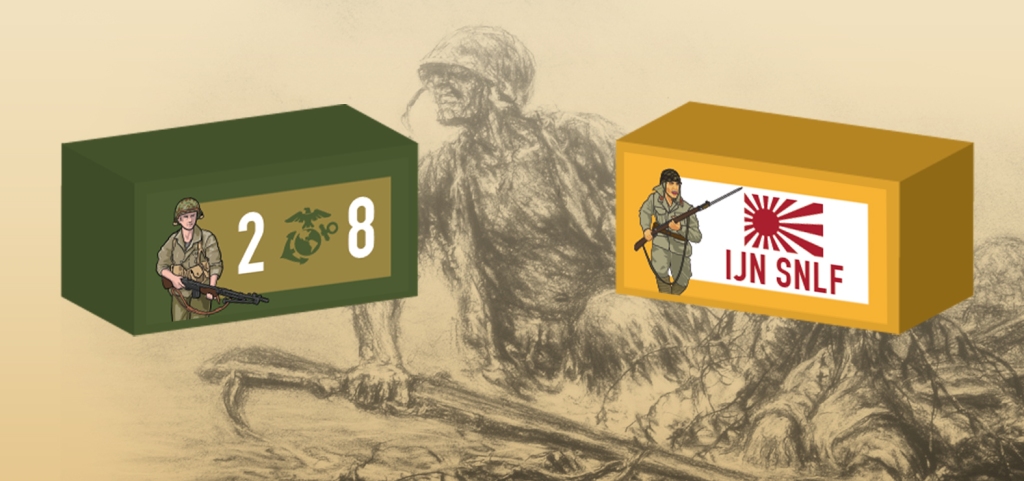
Here is a link to a play video that is found on the Kickstarter page:
If you are interested in Tarawa 1943, you can check out the game on the Kickstarter page which launched on January 23rd at the following link: https://www.kickstarter.com/projects/1456271622/612304702?ref=947juo&token=b85beab9
-Grant K.

A lot of this is a repetition of what can be seen on the Kickstarter video, and it is good to know there’s enough different to make this a good read. I can hear Grant’s passion about the game design and the flow of play through his tone, and that lends a great deal of credibility to how the game will play. I laughed when I saw he hadn’t won yet on the (difficult) 21-card Japanese deck, and I relish the thought of trying that level after I’ve learned the game’s system well enough. jPj
LikeLiked by 1 person